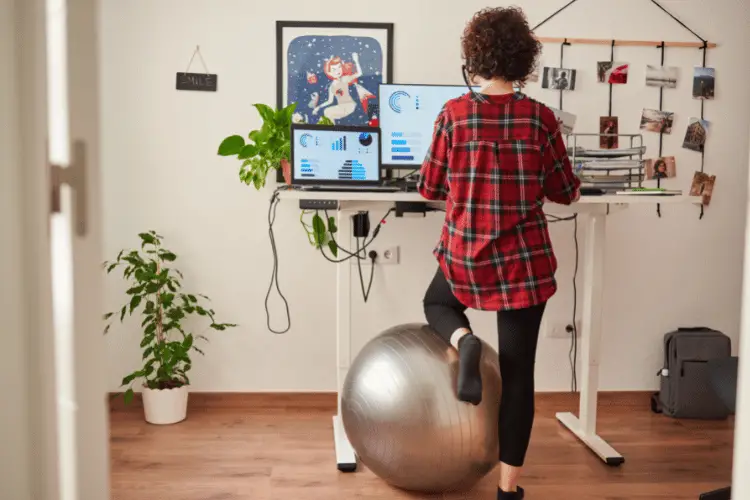The secret to a long, healthy life starts by viewing fitness as a lifestyle rather than a quick sprint.
By slowly changing your everyday habits, you’ll develop healthy practices that’ll improve countless areas of your life.
From finding healthier food options to finding calorie-burning activities you enjoy, this article discusses some of the best methods on how to make fitness a lifestyle.
Let’s dive right in!
1. Find Things You Enjoy and Incorporate Them Into Your Lifestyle
Ask yourself this: what do you enjoy doing the most during your free time? Exploring the outdoors? Swimming? Dancing? Whatever the activity is, try to incorporate it into your lifestyle (i.e. daily or weekly routine) as much as possible.
For example, take the scenic route when walking home or get off the subway/bus at an earlier stop and walk the extra distance. Sign up for a pool membership and go swimming at least once a week. Take up some dance classes or dance to an upbeat song while doing work at home.
The goal is to keep yourself active while doing something you love. Being more active not only benefits you physically but also mentally; it sharpens your memory, boosts your self-esteem, promotes better sleep, and makes you feel stronger and more energized.
When I’m talking with sedentary people, I often suggest taking a walk once a week and the response I get back is “Well, what will that do for my health?” The truth is that it will help your overall health A LOT. I could go into the science, but you’ll never know for yourself if you don’t try.
2. Cut Calories While Enjoying Your Favorite Foods
When I say, “cut calories,” I don’t mean eating less of your favorite food. Instead, find a way to make your favorite foods healthier and less calorie dense. Search for recipes with healthier alternatives so you can enjoy your favorite food without the guilt or energy crash of splurging.
Here are some ideas:
- Pizza: Instead of opting for thick-crust meat pizzas, lean more towards thin-crust variants and load it up with healthier veggie toppings—mushrooms, spinach, bell peppers, artichoke hearts, etc. If you’re one to make pizza at home, substitute the pizza crust with wheat pita or whole tortilla. Quest also makes a high-protein pizza that you can cook at home.
- Mac and Cheese: Replace the macaroni with cauliflower and opt for low-fat cheese.
- French Fries: Homemade fries are often healthier than the fast-food variety. Cut up a whole potato, then pop the chopped-up potatoes in the oven at 450 or 475 degrees until they turn gold.
- Pasta: Replace white pasta with whole wheat pasta or zoodles (zucchini noodles). Add a source of protein like chicken or shrimp, and top it up with veggies.
- Burgers: Load up your burgers with vegetables. Instead of cheese and mayo, use tomato, lettuce, jalapenos, and onions. To cut some of the fat and calories, replace beef with a turkey, chicken, or veggie patty. If you still want beef, use bison meat. Bison meat has fewer calories and saturated fats than traditional ground beef.
- Tacos: Replace ground beef with ground turkey and full-fat sour cream with nonfat yogurt. Top it up with black beans and homemade guacamole to get a dose of heart-healthy monounsaturated fat.
- Buffalo Wings: Baked chicken wings are way healthier than deep-fried chicken wings. Prepare the wings with dry seasonings instead of sauces to enhance the crispiness and cut down on the fat even more.
With hundreds of healthier alternatives around, there’s no reason to give up your favorite food. Use your creativity and transform your fav junk foods into healthy meals. That way, you get the health benefits without compromising flavor!
If you’re just starting this effort to live healthier, allow yourself a small indulgence here and there. I’ve seen too many people go too hard too fast and then just quit.
For example, instead of getting a family-sized bag of chips, get yourself a snack-sized one. These little changes turn into big changes when done over long periods of time.
3. Be Mindful of What You Drink
Sugary drinks have been linked to various health issues, including type 2 diabetes, obesity, weight gain, and increased risk of cancer and heart disease. Therefore, it’s best to cut them off from your diet completely.
Replace sugary drinks with healthy alternatives like flavored sparkling water, coconut water. Or you can just drink plain water. Coffee and tea, without added sugar or sweeteners, are similarly healthy choices. Swapping to black coffee can be an adjustment, but it’s actually amazing once you really start to taste the differences in each brand/flavor of coffee.
Drinks with low-calorie sweeteners, like diet drinks, should be consumed in moderation.
According to the U.S. National Academies of Sciences, Engineering, and Medicine, men need to drink about 15.5 cups (3.7 liters) of fluids whereas women need to drink 11.5 cups (2.7 liters) of fluids a day.
Drinking the right amount of liquid a day helps maximize your physical performance, prevents and treats headaches, and aids in weight loss.
4. Add Physical Activity to Your Family’s Routine

As much as possible, incorporate physical activity as part of your family’s everyday routine.
Establish physical goals that you can achieve together, like walking 30 minutes a day three times a week or playing backyard games like baseball, badminton, or even just tossing a ball around. By doing so, your transition to a fit lifestyle will feel more natural and seamless.
Staying active keeps your family upbeat, calm, and healthy. It’ll also increase your bond as a family. Here are some fun ways to keep your family active:
- Go for a family walk or jog at least once a week. Explore different routes and local trails around your neighborhood to keep the walks interesting.
- Play dance-based video games with your family.
- Hold a nature scavenger hunt with your children or siblings. Make a list of items to find, such as rocks, leaves, acorns, animals, or items of a specific color, then send them off to find the said item in the backyard or around the neighborhood. Just make sure they stay in sight!
- Celebrate special occasions like anniversaries, birthdays, graduations, etc. with a fun physical activity. Examples include hiking, swimming at the beach, biking, ice skating, and snowboarding.
- Get the whole family involved in household chores.
- Schedule family playtime, where you play a game of tag, hula-hoop, hide-and-seek, or a backyard sport after dinner each night.
- Buy children toys that encourage physical activity, like balls, skateboards, kites, jump ropes, skates, bikes, and punch balloons.
5. Build a Garden
If you’re a plant lover, take the opportunity to build a garden in your backyard.
Gardening is an inherently physical activity; a 30-to-45-minute task out in the yard can burn up to 300 calories. It works all the major muscle groups in the body: arms, legs, buttocks, back, shoulders, and abdomen. Tasks that use these muscles build strength, mobility, and flexibility.
So if you want to make fitness a lifestyle, incorporate gardening (and subsequently landscaping) into your daily routine.
Treat it like any workout; stretch for 10 minutes, then alternate light activities with heavier ones. Dig a few holes, rake up some stray leaves, pick veggies and flowers, and prune dead crops.
Use manual clippers, push mowers, and shears instead of electric-powered tools to work your legs, upper body, and core.
Bonus points if you get your family involved. Use it as a backdrop for fun games, like seeing who digs the deepest ditch or pulls out the most weeds. See who’s plants grow the tallest. Gardening is a fantastic way to bond with your family and increase physical activity.
Affiliate Disclosure: We may earn a commission if you click a link on our site and make a purchase. For more info, see our disclaimer.
6. Make Screen Time an Active Time
Screen time doesn’t have to be a sedentary activity.
Instead of sitting while watching TV or playing video games, walk on a treadmill, jog in place, lift weights, or do yoga.
If you’re one to binge TV shows, break the watch time with a bit of activity between episodes or during commercials, like jumping jacks, push-ups, squats, or stretches.
If you don’t want to stand up between breaks or while watching TV, use a seated elliptical trainer like Cubii. This machine allows you to exercise your feet and legs while sitting on the couch.
If you have the time, why not participate in a weekly or bi-weekly Virtual Fitness event? Virtual events allow you to participate in exercise challenges while you’re at home. Some of these events can be done in front of the TV, like the Press-up Challenge, Plank Challenge, and Squat Challenge. Some even give you the opportunity to raise money for charity or earn medals.

7. Take It One Step at a Time, But Don’t Stray Too Far Behind
If you’re just starting out, take it one step at a time. Lifestyle changes aren’t the easiest to implement, especially if you’re going from sedentary to active. Start small and progressively build your goals from there. Set up easy-to-accomplish tasks like eating at least one green veggie or working out at least 10 minutes every day.
As the adage goes, slow and steady wins the race. If your goals are overly difficult or ambitious, you might not be able to sustain them for long. It’s always better to master a couple of habits than be a jack-of-all-trades that does dozens of things at the same time.
That said, don’t “play it safe” and stray too far behind your fitness goals. If one of your goals is continuous improvement, you need to willingly take up new challenges.
When it comes to exercise, treat it like medicine. You’ll get the most benefits when you do the prescribed amount. If you go over the prescribed amount, you’ll not only lose benefits but also increase your risk of injury.
Eventually, though, you’ll build tolerance. Your old exercises won’t be as beneficial as they were before. You know you need to increase workout intensity when:
- You stopped losing weight
- Your heart isn’t beating fast after an exercise
- You’re not breaking a sweat after an exercise
- You’re doing less effort to complete your exercise
- You don’t feel like you’re pushing yourself
- You haven’t increased the intensity in a while
If you exercise the same way every day for months on end, you might get stuck on a plateau and lose motivation and interest to exercise.
Consistency is important for hitting your body goals but staying in the same routine for too long causes more damage than harm.
Therefore, you should always incorporate more challenging exercises into your routine. Both your mind and your body will tell you when it’s time for a change in training.
8. Don’t Be Afraid to Try Out New Things
Embrace the unknown. You never know what you’re missing until you try. If it works out well, fantastic—you’ve found yourself a new activity to busy yourself with. If it doesn’t, there’s no harm done. At the very least, you’ve learned something about yourself. The important thing here is to step out of your comfort zone and switch things out to keep things interesting.
Look around your area and check out the activities it offers. You don’t have to dedicate yourself to mastering the craft—just try it out and see how it goes. Try a new fitness routine with friends, take a swimming class, partake in some Karate or other martial arts, or join a new sport. If you’re into the outdoors, take a wilderness survival course.
Make a list of things you want to try this month and dedicate yourself to testing them all out. By trying out new things every so often, you’ll stay motivated to make fitness a permanent lifestyle.
9. When It Comes to Exercise, Some Is Always Better Than None
We all have those days when energy and motivation escape us; when exercise doesn’t sound as enticing as lazing around in bed all day.
But I’ve got some good news for you, weekend warriors: some exercise is always better than no exercise.
If you’re not in the mood or don’t have time to complete a 45-minute exercise routine, you can get away with doing only 10. You don’t even have to leave the bed—you can exercise right there, with your back on the mattress.
Ideally, you want to exercise several times a week for at least 30 to 45 minutes to stay fit and healthy.
But according to a study published in JAMA Internal Medicine, exercising even once or twice a week is enough to reduce health complications and the risk of death from cancer, heart disease, and other causes.
The study concludes that any amount of exercise helped cut the risk of health-related issues by 40% compared to people who don’t exercise.
Any bout of physical activity contributes to a happier and healthier you. That said, don’t take this as an excuse to do the bare minimum of work each day. You need to train yourself to get up and exercise to keep a healthy lifestyle.
Whenever you choose inactivity over activity, you’re choosing the path of least resistance. In the long run, that path will turn into regrets and “what ifs.” So, take control of your mind and body. Don’t succumb to laziness.
10. Make Small Adjustments to Your Everyday Routine

One of the most effective ways of turning fitness into a lifestyle is by implementing some micro-adjustments to your everyday routine. These adjustments include:
- Walking or biking home instead of taking the car, subway, or bus
- Swapping your chair for an exercise ball
- Limiting your nicotine and alcohol intake
- Taking the stairs instead of the elevator/escalator
- Bringing a water bottle with you wherever you go, and striving to finish it before you arrive home
- Swapping a cup of coffee with a cup of green tea
- Cutting out artificial sweeteners in beverages.
- Getting at least 15 minutes of sunlight every day
- Parking a distance away from work or the grocery store and walking briskly to your destination
- Instead of emailing or calling a colleague, walk to their workstation and talk to them directly
- Stretching regularly while working on your desk
These changes, while small, set you up for better long-term health. They add up to big results over time and save you during instances where you physically can’t make the time to go to the gym or exercise.
11. Reward Yourself for Your Accomplishments
To keep yourself motivated, reward yourself every time you accomplish a goal, regardless of how small.
It can be something as simple as watching an episode of your favorite show or reading a chapter of a book, or something more tangible like getting a massage or purchasing a new workout gear.
You can even indulge in a treat now and again. Just make sure the reward doesn’t derail you from your fitness goals.
Here are some reward ideas:
- Get a manicure/pedicure, a facial, or a full spa session
- Watch a movie in the theaters
- Get a new planner or journal
- Go to the beach with friends and/or family
- Get a new haircut or hair color
- Visit a comedy club or a concert
- Buy a new outfit
- Take a day off work
- Purchase a new book
- Buy a new set of cookware
Final Thoughts
Turning fitness into a lifestyle takes some time and effort, so don’t beat yourself up if you don’t accomplish your goals straight away. Set small, achievable tasks and gradually increase their difficulty as you go. Fall in love with the process and be easy on yourself. Good luck!


